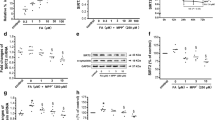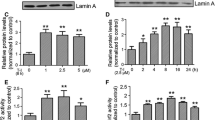Abstract
Accumulated oxidative damage plays key roles in the pathogenesis of Parkinson’s disease (PD). Silent mating type information regulation 2 homolog 1 (SIRT1), a class III histone deacetylase, can directly activate peroxisome proliferator-activated receptor-c coactivator-1α (PGC-1α) and attenuate oxidative stress. Alpha-lipoic acid (ALA) is a natural antioxidant that has been demonstrated to protect PC12 cells against 1-methyl-4-phenylpyridinium (MPP+). However, the underlying mechanisms related to changes in cell signaling cascades are not fully understood. In the present study, the neuroprotective effect of ALA and the potential role of ALA in the SIRT1 pathway was investigated in vitro and in a mouse model of PD. A Cell Counting Kit-8 (CCK-8) assay was performed to detect the SY5Y-SH cell viability. Immunohistochemistry, quantitative real-time polymerase chain reaction and western blot assays were used to evaluate the expression of tyrosine hydroxylase (TH), SIRT1, and PGC-1α in vivo and in vitro. Intracellular reactive oxygen species (ROS) production and tissue SOD and MDA were detected by the corresponding assay kits. The results showed that ALA notably prevented oxidative stress and neurotoxicity in vivo and in vitro against 1-methyl-4-phenyl-1, 2, 3, 6-tetrahydropyridine (MPTP)/MPP+. Furthermore, ALA significantly increased the expression of SIRT1 and PGC-1α in vivo and in vitro in MPTP/MPP+-induced models, which was reversed by the SIRT1 inhibitor EX527. These results suggested that ALA prevented oxidative stress and that neurotoxicity was involved in the upregulation of SIRT1 and PGC-1α in PD mice.





Similar content being viewed by others
Abbreviations
- SIRT1:
-
Silent mating type information regulation 2 homolog 1
- PGC-1α:
-
Peroxisome proliferator-activated receptor-c coactivator-1α
- ALA:
-
Alpha-lipoic acid
- PD:
-
Parkinson’s disease
- TH:
-
Tyrosine hydroxylase
- MPP+ :
-
1-Methyl-4-phenylpyridinium
- MPTP:
-
1-Methyl-4-phenyl-1, 2, 3, 6-tetrahydropyridine
- ROS:
-
Reactive oxygen species
- MS:
-
Multiple sclerosis
- EAE:
-
Experimental allergic encephalomyelitis
- Veh:
-
Vehicle
- DMEM/F-12:
-
Dulbecco’s modified Eagle’s medium: F-12
- FBS:
-
Fetal bovine serum
- H2DCF-DA:
-
2,7-Dichlorodihydro-fluorescein diacetate
- MAO-B:
-
Monoamine oxidase-B
- CCK-8:
-
Cell counting kit-8
References
Andreassen OA, Ferrante RJ, Dedeoglu A, Albers DW, Klivenyi P, Carlson EJ, Epstein CJ, Beal MF (2001a) Mice with a partial deficiency of manganese superoxide dismutase show increased vulnerability to the mitochondrial toxins malonate, 3-nitropropionic acid, and MPTP. Exp Neurol 167:189–195
Andreassen OA, Ferrante RJ, Klivenyi P, Klein AM, Dedeoglu A, Albers DS, Kowall NW, Beal MF (2001b) Transgenic ALS mice show increased vulnerability to the mitochondrial toxins MPTP and 3-nitropropionic acid. Exp Neurol 168:356–363
Andrews AM, Ladenheim B, Epstein CJ, Cadet JL, Murphy DL (1996) Transgenic mice with high levels of superoxide dismutase activity are protected from the neurotoxic effects of 2′-NH2-MPTP on serotonergic and noradrenergic nerve terminals. Mol Pharmacol 50:1511–1519
Blum D, Torch S, Lambeng N, Nissou M, Benabid AL, Sadoul R, Verna JM (2001) Molecular pathways involved in the neurotoxicity of 6-OHDA, dopamine and MPTP: contribution to the apoptotic theory in Parkinson’s disease. Prog Neurobiol 65:135–172
Broussy S, Laaroussi H, Vidal M (2020) Biochemical mechanism and biological effects of the inhibition of silent information regulator 1 (SIRT1) by EX-527 (SEN0014196 or selisistat). J Enzyme Inhib Med Chem 35:1124–1136
Bruck D, Wenning GK, Stefanova N, Fellner L (2016) Glia and alpha-synuclein in neurodegeneration: a complex interaction. Neurobiol Dis 85:262–274
Cartoni R, Leger B, Hock MB, Praz M, Crettenand A, Pich S, Ziltener JL, Luthi F et al (2005) Mitofusins 1/2 and ERRalpha expression are increased in human skeletal muscle after physical exercise. J Physiol 567:349–358
Chen C, Zhou M, Ge Y, Wang X (2020) SIRT1 and aging related signaling pathways. Mech Ageing Dev 187:111215
Corpas R, Revilla S, Ursulet S, Castro-Freire M, Kaliman P, Petegnief V, Gimenez-Llort L, Sarkis C et al (2017) SIRT1 overexpression in mouse hippocampus induces cognitive enhancement through proteostatic and neurotrophic mechanisms. Mol Neurobiol 54:5604–5619
Dabrowska A, Venero JL, Iwasawa R, Hankir MK, Rahman S, Boobis A, Hajji N (2015) PGC-1alpha controls mitochondrial biogenesis and dynamics in lead-induced neurotoxicity. Aging (albany NY) 7:629–647
de Lau LM, Breteler MM (2006) Epidemiology of Parkinson’s disease. Lancet Neurol 5:525–535
Eschbach J, von Einem B, Muller K, Bayer H, Scheffold A, Morrison BE, Rudolph KL, Thal DR et al (2015) Mutual exacerbation of peroxisome proliferator-activated receptor gamma coactivator 1alpha deregulation and alpha-synuclein oligomerization. Ann Neurol 77:15–32
Farr SA, Price TO, Banks WA, Ercal N, Morley JE (2012) Effect of alpha-lipoic acid on memory, oxidation, and lifespan in SAMP8 mice. J Alzheimers Dis 32:447–455
Fu B, Zhang J, Zhang X, Zhang C, Li Y, Zhang Y, He T, Li P et al (2014) Alpha-lipoic acid upregulates SIRT1-dependent PGC-1alpha expression and protects mouse brain against focal ischemia. Neuroscience 281:251–257
Guo YJ, Dong SY, Cui XX, Feng Y, Liu T, Yin M, Kuo SH, Tan EK et al (2016) Resveratrol alleviates MPTP-induced motor impairments and pathological changes by autophagic degradation of alpha-synuclein via SIRT1-deacetylated LC3. Mol Nutr Food Res 60:2161–2175
Hayashi-Takagi A, Yagishita S, Nakamura M, Shirai F, Wu YI, Loshbaugh AL, Kuhlman B, Hahn KM et al (2015) Labelling and optical erasure of synaptic memory traces in the motor cortex. Nature 525:333–338
Hayes MT (2019) Parkinson’s disease and Parkinsonism. Am J Med 132:802–807
Jiang T, Yin F, Yao J, Brinton RD, Cadenas E (2013) Lipoic acid restores age-associated impairment of brain energy metabolism through the modulation of Akt/JNK signaling and PGC1alpha transcriptional pathway. Aging Cell 12:1021–1031
Knight JR, Milner J (2012) SIRT1, metabolism and cancer. Curr Opin Oncol 24:68–75
Langston JW, Ballard P, Tetrud JW, Irwin I (1983) Chronic Parkinsonism in humans due to a product of meperidine-analog synthesis. Science 219:979–980
Liang D, Zhuo Y, Guo Z, He L, Wang X, He Y, Li L, Dai H (2020) SIRT1/PGC-1 pathway activation triggers autophagy/mitophagy and attenuates oxidative damage in intestinal epithelial cells. Biochimie 170:10–20
Liu L, Yang S, Wang H (2021) alpha-Lipoic acid alleviates ferroptosis in the MPP(+) -induced PC12 cells via activating the PI3K/Akt/Nrf2 pathway. Cell Biol Int 45:422–431
Livak KJ, Schmittgen TD (2001) Analysis of relative gene expression data using real-time quantitative PCR and the 2(-Delta Delta C(T)) Method. Methods 25:402–408
Molz P, de Freitas BS, Uberti VH, da Costa KM, Kist LW, Bogo MR, Schroder N (2021) Effects of lipoic acid supplementation on age- and iron-induced memory impairment, mitochondrial DNA damage and antioxidant responses. Eur J Nutr 60:3679–3690
Mudo G, Makela J, Di Liberto V, Tselykh TV, Olivieri M, Piepponen P, Eriksson O, Malkia A et al (2012) Transgenic expression and activation of PGC-1alpha protect dopaminergic neurons in the MPTP mouse model of Parkinson’s disease. Cell Mol Life Sci 69:1153–1165
Ng F, Wijaya L, Tang BL (2015) SIRT1 in the brain-connections with aging-associated disorders and lifespan. Front Cell Neurosci 9:64
Piechota-Polanczyk A, Zielinska M, Piekielny D, Fichna J (2016) The influence of lipoic acid on caveolin-1-regulated antioxidative enzymes in the mouse model of acute ulcerative colitis. Biomed Pharmacother 84:470–475
Rogina B, Helfand SL (2004) Sir2 mediates longevity in the fly through a pathway related to calorie restriction. Proc Natl Acad Sci U S A 101:15998–16003
Schettler V, Methe H, Staschinsky D, Schuff-Werner P, Muller GA, Wieland E (1999) Review: the oxidant/antioxidant balance during regular low density lipoprotein apheresis. Ther Apher 3:219–226
Schmidt N, Ferger B (2001) Neurochemical findings in the MPTP model of Parkinson’s disease. J Neural Transm (vienna) 108:1263–1282
Solmonson A, DeBerardinis RJ (2018) Lipoic acid metabolism and mitochondrial redox regulation. J Biol Chem 293:7522–7530
St-Pierre J, Drori S, Uldry M, Silvaggi JM, Rhee J, Jager S, Handschin C, Zheng K et al (2006) Suppression of reactive oxygen species and neurodegeneration by the PGC-1 transcriptional coactivators. Cell 127:397–408
Tae IH, Son JY, Lee SH, Ahn MY, Yoon K, Yoon S, Moon HR, Kim HS (2020) A new SIRT1 inhibitor, MHY2245, induces autophagy and inhibits energy metabolism via PKM2/mTOR pathway in human ovarian cancer cells. Int J Biol Sci 16:1901–1916
Tang BL (2016) Sirt1 and the mitochondria. Mol Cells 39:87–95
Thirupathi A, de Souza CT (2017) Multi-regulatory network of ROS: the interconnection of ROS, PGC-1 alpha, and AMPK-SIRT1 during exercise. J Physiol Biochem 73:487–494
Tipton KF, Singer TP (1993) The radiochemical assay for monoamine oxidase activity. Problems and Pitfalls Biochem Pharmacol 46:1311–1316
Wang Y, Zhou Y, Wang X, Zhen F, Chen R, Geng D, Yao R (2019) Osthole alleviates MPTP-induced Parkinson’s disease mice by suppressing Notch signaling pathway. Int J Neurosci 129:833–841
Wareski P, Vaarmann A, Choubey V, Safiulina D, Liiv J, Kuum M, Kaasik A (2009) PGC-1{alpha} and PGC-1{beta} regulate mitochondrial density in neurons. J Biol Chem 284:21379–21385
Watanabe S, Ageta-Ishihara N, Nagatsu S, Takao K, Komine O, Endo F, Miyakawa T, Misawa H et al (2014) SIRT1 overexpression ameliorates a mouse model of SOD1-linked amyotrophic lateral sclerosis via HSF1/HSP70i chaperone system. Mol Brain 7:62
Xu Y, Nie L, Yin YG, Tang JL, Zhou JY, Li DD, Zhou SW (2012) Resveratrol protects against hyperglycemia-induced oxidative damage to mitochondria by activating SIRT1 in rat mesangial cells. Toxicol Appl Pharmacol 259:395–401
Yadav V, Marracci GH, Munar MY, Cherala G, Stuber LE, Alvarez L, Shinto L, Koop DR et al (2010) Pharmacokinetic study of lipoic acid in multiple sclerosis: comparing mice and human pharmacokinetic parameters. Mult Scler 16:387–397
Yamamoto H, Schoonjans K, Auwerx J (2007) Sirtuin functions in health and disease. Mol Endocrinol 21:1745–1755
Zhang Y, Anoopkumar-Dukie S, Arora D, Davey AK (2020) Review of the anti-inflammatory effect of SIRT1 and SIRT2 modulators on neurodegenerative diseases. Eur J Pharmacol 867:172847
Zhang Z, Lai D, Wang L, Yu P, Zhu L, Guo B, Xu L, Zhou L et al (2014) Neuroprotective effects of the andrographolide analogue AL-1 in the MPP(+)/MPTP-induced Parkinson’s disease model in vitro and in mice. Pharmacol Biochem Behav 122:191–202
Funding
This work was supported by Department of Health of Hebei Province (Grant No. 20200890).
Author information
Authors and Affiliations
Corresponding authors
Ethics declarations
Conflict of Interest
The authors declare no competing interests.
Additional information
Publisher's Note
Springer Nature remains neutral with regard to jurisdictional claims in published maps and institutional affiliations.
Rights and permissions
About this article
Cite this article
Zhang, J., Gao, Y., Zhang, L. et al. Alpha-Lipoic Acid Attenuates MPTP/MPP+-Induced Neurotoxicity: Roles of SIRT1-Dependent PGC-1α Signaling Pathways. Neurotox Res 40, 410–419 (2022). https://doi.org/10.1007/s12640-022-00479-6
Received:
Revised:
Accepted:
Published:
Issue Date:
DOI: https://doi.org/10.1007/s12640-022-00479-6




